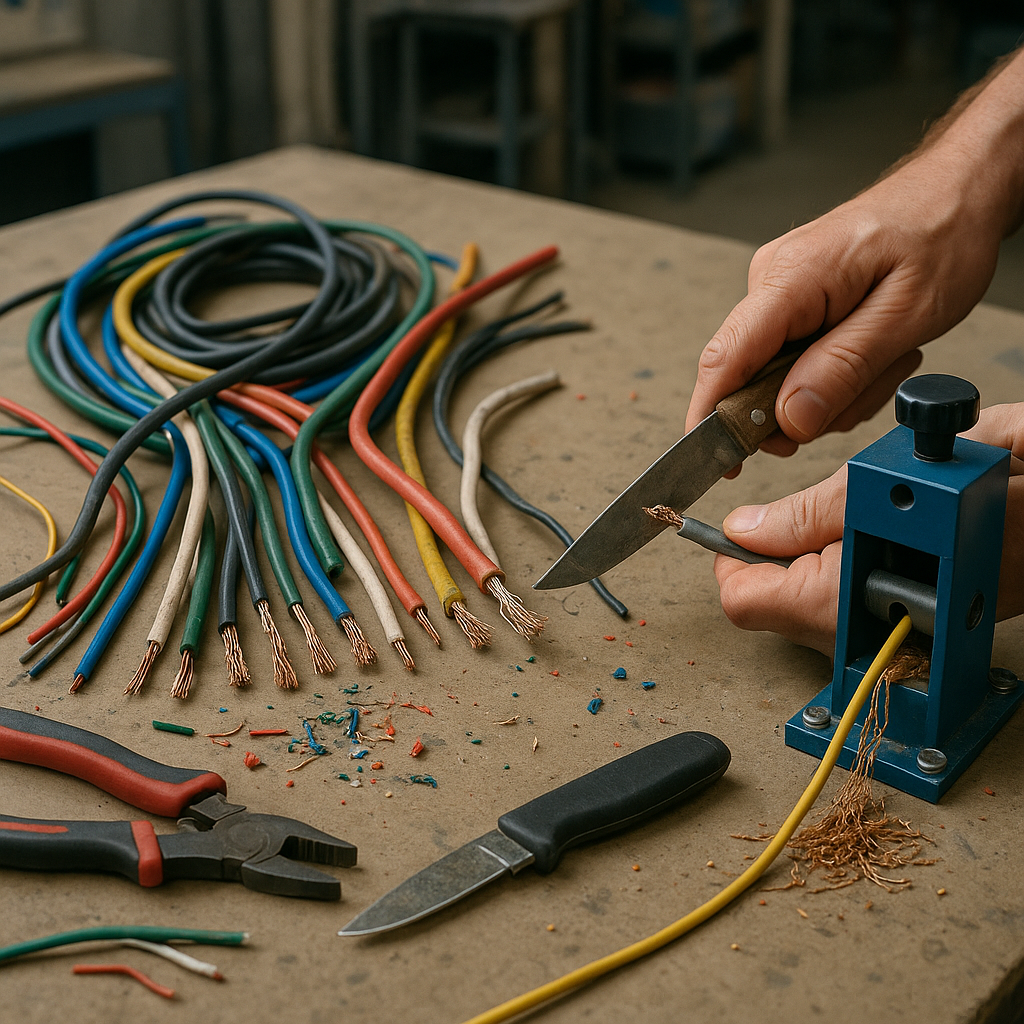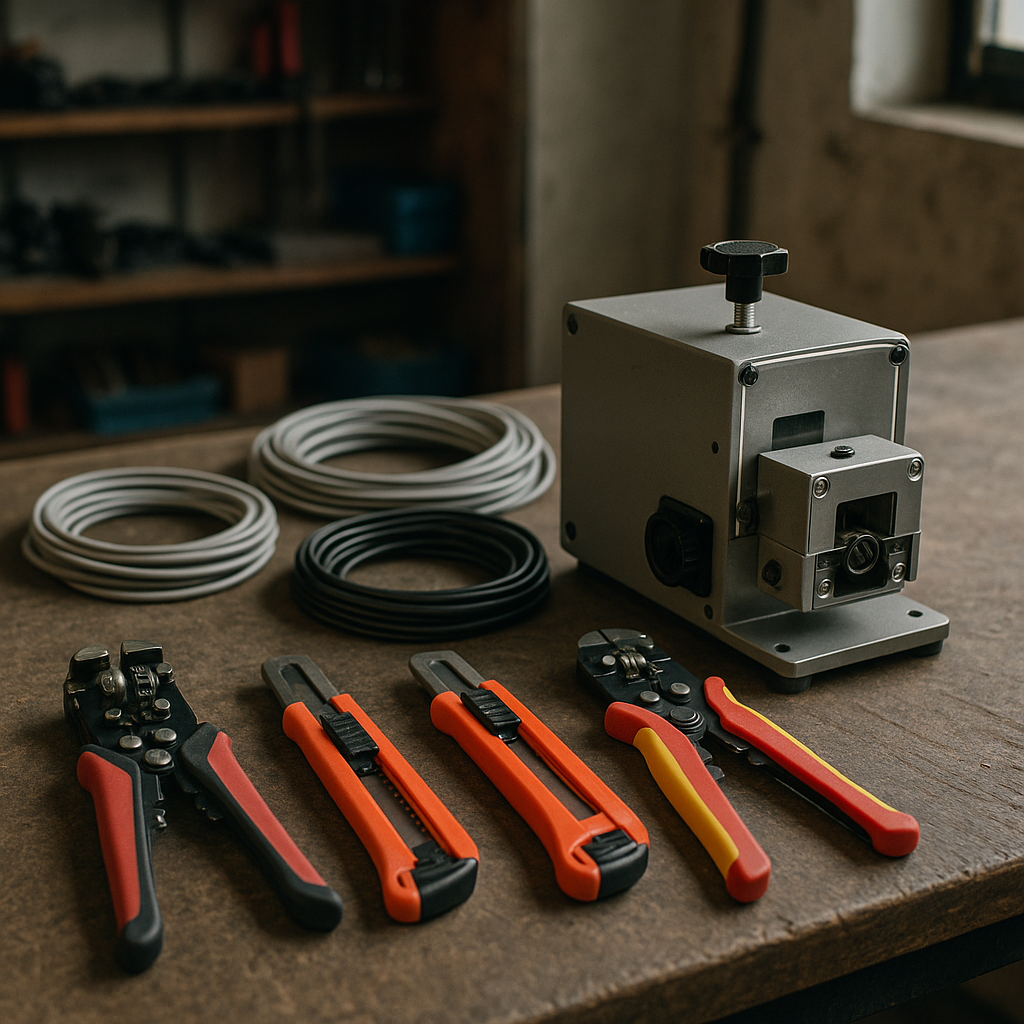5901 Botham Jean Blvd, Dallas, TX 75215
What are the Methods of Removing Plastic from Scrap Wire?
October 14, 2025In the world of recycling, few materials offer the combination of value and sustainability that copper provides. Hidden beneath layers of plastic insulation, this valuable metal awaits recovery from countless miles of discarded wire. Properly removing this plastic coating presents both an opportunity and a challenge for recyclers.
The process of stripping insulation from scrap wire serves a dual purpose. It allows for the recovery of valuable copper, which can be recycled with nearly 90% efficiency. At the same time, it enables the proper separation and disposal of plastic materials that might otherwise end up in landfills. This separation is crucial for maximizing the scrap value, as bare copper commands significantly higher prices than insulated wire.
Yet, this seemingly simple task presents several practical hurdles. Without proper techniques or equipment, strippers risk damaging the copper core, reducing its value. The varying thicknesses and types of insulation further complicate the process. From thin household lamp cords to thick industrial cables, each wire type requires specific handling to ensure efficient and safe insulation removal.
What Are the Different Methods for Removing Plastic from Scrap Wire?

Removing plastic insulation from scrap wire is crucial for effective recycling and maximizing the value of recovered copper. The industry offers various methods that differ in cost, efficiency, and scale. From simple hand tools for DIY recyclers to advanced industrial machinery for large operations, the right method depends on your volume, budget, and specific requirements.
Manual Stripping Methods
For small-scale operations or occasional recycling, manual methods provide cost-effective solutions without significant investment. These approaches require more labor but can be efficient for smaller quantities.
- Wire Strippers – Handheld wire strippers feature precisely sized notches that cut through insulation without damaging the metal core. Insert the wire, squeeze the handles, and pull to remove the insulation. These tools work best for standard gauge wires and are widely available at hardware stores.
- Utility Knives – A sharp utility knife can score the insulation lengthwise before peeling it away. This method requires careful technique to avoid damaging the copper wire or causing injury. Many scrappers develop their own techniques, such as making a shallow cut along the wire’s length and then pulling the insulation off.
- Wire Scraper Tools – Specialized scraper tools feature a notch that strips insulation as you pull the wire through. These tools offer better safety than utility knives and work well for consistent wire gauges.
Heat-Based Stripping Techniques
Heat methods leverage the different melting points between copper and plastic insulation, making separation more efficient than purely mechanical approaches.
- Controlled Wire Burning – While controversial and potentially harmful to the environment, some recyclers burn the insulation off wires. This practice is strictly regulated in many areas due to toxic fumes released during burning. Professional operations use specialized combustion chambers with emission controls.
- Heat Guns – Industrial heat guns can soften the insulation without burning it, making it easier to remove. This method requires proper ventilation as some insulation materials release harmful fumes when heated.
- Thermal Wire Strippers – These specialized tools use precisely controlled heat to melt through insulation without affecting the copper. They are particularly useful for delicate wires where mechanical methods might damage the conductor.
Mechanical Stripping Solutions
For medium to large operations, mechanical stripping solutions offer a balance of efficiency and investment. These tools can significantly increase processing speed compared to manual methods.
- Drill-Powered Strippers – These devices attach to standard power drills and use rotating blades to cut and remove insulation. They are popular among small-scale recyclers who need to process moderate amounts of wire regularly.
- Benchtop Wire Stripping Machines – These standalone units feature a motor-driven mechanism that pulls wire through a cutting blade. Many models accommodate various wire gauges through adjustable settings, typically handling wires from 0.06″ to 1″ in diameter.
- Cable Granulators – For processing large quantities of mixed wires, granulators shred both wire and insulation together. The resulting mixture is then separated using air classification or other sorting methods that exploit the density difference between copper and plastic.
Industrial Automated Solutions
For commercial recycling operations processing large volumes, automated systems provide the highest efficiency and throughput.
- Fully Automated Wire Stripping Machines – These sophisticated systems can process hundreds of feet of wire per minute, automatically adjusting to different wire gauges. Most feature multiple channels to accommodate various wire sizes simultaneously and can be operated continuously for high-volume processing.
- Industrial Wire Chopping Lines – Complete systems that chop, granulate, and separate metals from insulation in one continuous operation. These systems typically include magnetic separation to remove ferrous materials and density separation tables to isolate copper from plastic.
- Dewiring Machines – Specialized equipment designed for removing steel or copper wires from bales of recycled materials. These machines cut and extract wires while preserving the surrounding materials, making them valuable for processing complex recyclables.
Choosing the Right Method
Selecting the appropriate wire stripping method depends on several key factors:
- Volume – The quantity of wire processed regularly will determine whether manual methods are sufficient or if automation is necessary.
- Wire Type – Different wire gauges and insulation materials may require specific techniques. For instance, very fine wires might be damaged by aggressive mechanical methods.
- Budget – Investment costs range from under $50 for basic hand tools to tens of thousands for industrial systems.
- Environmental Considerations – Some methods generate waste or emissions that may require permits or specialized handling procedures.
For occasional recyclers working with small amounts of wire, manual tools offer a practical starting point. Those handling regular volumes might benefit from mechanical solutions like drill-powered or benchtop strippers. Commercial operations typically require automated systems to achieve the throughput necessary for profitability.
As the value of copper continues to rise, efficient wire stripping becomes increasingly important to recycling economics. By selecting the right method for your specific needs, you can maximize recovery rates while minimizing labor and processing costs.
What Tools and Equipment Are Used for Efficient Wire Stripping?

Wire stripping is a crucial process in the recycling industry that requires the right tools for efficiency, safety, and maximizing material recovery. From basic hand tools to advanced machinery, selecting the appropriate equipment depends on volume, wire type, and budget considerations.
Manual Wire Strippers
Handheld wire strippers are essential for small-scale recycling operations or occasional wire processing. Gauged wire strippers feature precisely sized notches for different wire diameters, ensuring clean cuts without damaging the valuable copper conductor.
Needle nose wire strippers combine stripping functionality with the ability to reach tight spaces. These versatile tools often include cutting edges near the base, reducing the need to switch between multiple tools when processing different wires.
Universal wire strippers can handle multiple wire gauges and types, making them suitable for operations that process varied materials. The best models strip both solid and stranded copper wire and work with various insulation types, including PVC and THHN.
Automatic Wire Strippers
Automatic strippers significantly increase processing speed for medium-volume operations. These tools use a trigger mechanism to simultaneously grip the wire, cut the insulation, and pull it away in one smooth operation.
Self-adjusting automatic strippers adapt to different wire gauges without manual adjustment, making them ideal for recycling centers processing mixed wire types. Most models can handle wire ranges from 10-24 AWG, perfect for common residential and commercial electrical scrap.
For improved precision, advanced automatic strippers include adjustable strip-length gauges and depth settings. This ensures consistent results and prevents damage to valuable copper conductors, maximizing the value of recovered materials.
Drill-Powered Wire Strippers
Drill-powered stripping tools offer a compromise between manual and fully automated systems. These devices connect to standard power drills, providing mechanical assistance without the cost of dedicated powered equipment.
Most drill-powered strippers handle wire sizes from 0.06″ to 1″ (1.5-25mm), accommodating a wide range of scrap wire types. They’re particularly useful for recycling operations aiming to scale up from manual processing without major capital investment.
The primary advantage of these systems is mobility and flexibility. They can be transported to different collection sites or used in various locations within a recycling facility, improving operational efficiency.
Electric Wire Stripping Machines
For high-volume wire recycling, electric stripping machines offer unmatched efficiency. Entry-level electric strippers process wire at speeds of 15-30 meters per minute with relatively low power consumption (typically 180-250W).
Multi-channel electric strippers feature separate feed holes for different wire diameters, typically covering ranges from 0.06″ to 1″ (1.5-25mm). The adjustable blade systems allow operators to set precise cutting depths for different insulation thicknesses.
Advanced industrial models incorporate features like cooling fans for continuous operation, emergency stop buttons for safety, and reinforced frames for durability in demanding recycling environments. Some systems can process up to 75 feet per minute, greatly increasing throughput.
[[artifact_table]] Comparison of Wire Stripping Equipment by Processing Volume [[/artifact_table]]Industrial Wire Processing Systems
Large-scale recycling operations often employ granulators and separation systems that process entire cables. These machines shred the wire and use various separation technologies to isolate copper from insulation materials.
Industrial wire choppers can process hundreds of pounds of wire per hour, handling even large-gauge cables and complex wire assemblies. The resulting copper granules are often higher quality than those produced by other methods, commanding premium prices.
While these systems require significant capital investment, they dramatically reduce labor costs and maximize recovery rates. Many modern systems also incorporate dust collection and environmental controls to minimize workplace hazards and pollution.
Choosing the Right Equipment for Sustainability
When selecting wire stripping equipment, recyclers should consider not just processing speed but also energy efficiency and material recovery rates. Modern electric stripping machines consume relatively little power while maximizing the recovery of valuable copper.
For truly sustainable operations, look for equipment that facilitates the recovery of both copper and insulation materials. Some advanced systems can separate PVC and other insulation types for additional recycling instead of landfill disposal.
Finally, equipment durability is critical from both economic and environmental perspectives. Quality stripping tools with replaceable blades and serviceable components offer better long-term sustainability than disposable alternatives, reducing waste and resource consumption.
Conclusion: Choosing the Right Method for Your Wire Stripping Needs
The method you choose for wire stripping ultimately depends on three key factors: the scale of your project, the specific types of wire you’re processing, and your available resources. For small-scale operations handling less than 100 pounds of copper monthly, manual tools like razor blades, handheld wire strippers, or even potato peelers can be cost-effective solutions. These simple tools require minimal investment while still allowing you to recover valuable copper.
For medium to high-volume operations, investing in proper equipment is essential. Tabletop wire strippers offer a balance between affordability and efficiency for processing several hundred pounds monthly. Meanwhile, electric or hydraulic wire stripping machines deliver the highest throughput for commercial operations dealing with bulk quantities. These machines not only save considerable time but also ensure more consistent and safe wire processing. For optimal recycling outcomes and maximum value recovery, contact Okon Recycling at 214-717-4083.
